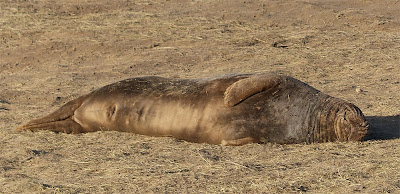The grey seal Halichoerus grypus is a large seal mammal that weighs between 105 to 310 kilogrammes. They are found throughout the year in British waters and could potentially turn up at any coastal site, but most likely along the northern Atlantic coast. The colouration of their fur varies from reddish brown to dark greyish black, but newborn pups have a yellowish-white pelage for the first two to four weeks of their life.
 |
| Grey Seal Pup - Donna Nook |
 |
| Grey Seal Pup - Donna Nook |
Grey seal mothers are extremely protective of their young and will remain in close attendance for the first couple of weeks. However after a couple of weeks the mother returns to the sea and leaves the pup to fend for itself. The pup will remain on shore for three to four weeks whilst its juvenile pelt moults out.
Females are extremely attentive of their young and will groom and scratch them, for some this appears quite irritating as the try to move away, whereas others snuggle up and enjoy the close attention.
Female grey seals come ashore only one or two days before giving birth, and become increasingly more restless just prior to birth. Whilst male grey seals take the opportunity to relax and soak up the sun. Grey seals are polygynous and males will compete actively with each other for the chance to mate with several females.
Males are much larger and bulkier than females and exhibit a distinctive long, convex muzzle that gives a 'Roman Nose' impression.
Giving birth and raising their young is a stressful thing for female grey seals, and when not suckling they take the time to catch up on some well earned rest, but always with a watchful eye on their young.
As the pups get older and their parents return to the sea, they moult into their adult type pelage. The colouration is still white but patches of dark grey form around the head and over the body.
For anyone wishing to see grey seals up close Donna Nook is an excellent location. Access to the seals is limited by the presence of a wooden fence which enables visitors to get within a metre without disturbing them, and allows for excellent photo opportunities.
| New born Grey Seal pup |
 |
| This new born pup was only around one hour old |
When a few days old, grey seal pups look extremely cute, but just after birth they can be covered in blood, and discarded placenta is lying everwhere...not the best thing if you are the slightest bit squeamish!
 |
| Mother with New Born Twins - the smaller pup in the foreground had been born within the hour. |
 |
| Mother and Calf Grey Seal |
Females are extremely attentive of their young and will groom and scratch them, for some this appears quite irritating as the try to move away, whereas others snuggle up and enjoy the close attention.
 |
| Pregnant Grey Seal ready to give birth |
Female grey seals come ashore only one or two days before giving birth, and become increasingly more restless just prior to birth. Whilst male grey seals take the opportunity to relax and soak up the sun. Grey seals are polygynous and males will compete actively with each other for the chance to mate with several females.
 |
| Male Srey Seal |
Males are much larger and bulkier than females and exhibit a distinctive long, convex muzzle that gives a 'Roman Nose' impression.
 |
| Female Grey Seal having a good scratch |
Females are smaller and slimmer (when not pregnant) but still exhibit the same distinctive head and nose shape, this can be seen above.
 |
| Female Grey Seal relaxing |
Giving birth and raising their young is a stressful thing for female grey seals, and when not suckling they take the time to catch up on some well earned rest, but always with a watchful eye on their young.
 |
| Young Pup Suckling its Mother |
As the pups get older and their parents return to the sea, they moult into their adult type pelage. The colouration is still white but patches of dark grey form around the head and over the body.
 |
| Juvenile Grey Seal without its new born pelage |
 |
| Juvenile Grey Seal without its new born pelage |
For anyone wishing to see grey seals up close Donna Nook is an excellent location. Access to the seals is limited by the presence of a wooden fence which enables visitors to get within a metre without disturbing them, and allows for excellent photo opportunities.

No comments:
Post a Comment